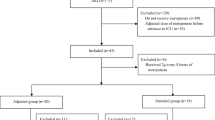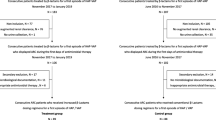Abstract
Introduction
Augmented renal clearance (ARC) defined as creatinine clearance (Clcr) above 130 mL/min/1.73m2 may lead to suboptimal antibacterial treatment. The aim of this study was to determine a strategy for meropenem administration to achieve both pharmacodynamic-pharmacokinetic (PK-PD) target (50%fT > MIC) and better clinical outcomes in patients with VAP and ARC.
Materials and methods
In this randomized clinical trial, patients with VAP and high risk for ARC were recruited. An 8-h urine collection was performed on the 1st, 3rd, and 5th days of study to measure Clcr. Included patients were divided into three groups: (1) 1 g meropenem, 3-h infusion, (2) 2 g meropenem, 3-h infusion, (3) 1 g meropenem, 6-h infusion. On the 2nd, 3rd, and 5th days of treatment, peak and trough blood samples were collected to undergo HPLC assay. MICs were assessed using microdilution method. Patients were also clinically monitored for 14 days.
Results
Forty-five patients were included. Group 3 showed significanty higher rate of patients achieving fT > MIC > 50% (100% for group 3 versus 40% for group 2 and 13% for group 1; p = 0.0001). Mean fT > MIC% was significantly higher in group 3 (78.77 ± 5.87 for group 3 versus 49.6 ± 7.38 for group 2 and 43.2 ± 7.98 for group 1; p = 0.0001). Statistical analysis showed no significant differences among groups regarding clinical improvement.
Conclusion
According to the findings of this trial, prolonged meropenem infusion is an appropriate strategy compared to dose elevation among ARC patients.



Similar content being viewed by others
Notes
Clinical Pulmonary Infection Score.
Acute kidney injury.
References
Mahmoud S, Shen C (2017) Augmented renal clearance in critical illness: an important consideration in drug dosing. Pharmaceutics 9(3):E36
Sime FB, Udy AA, Roberts JA (2015) Augmented renal clearance in critically ill patients: etiology, definition and implications for beta-lactam dose optimization. Curr Opin Pharmacol 24:1–6
Udy AA, Roberts JA, Lipman J (2013) Clinical implications of antibiotic pharmacokinetic principles in the critically ill. Intensive Care Med 39(12):2070–2082
Hobbs AL et al (2015) Implications of augmented renal clearance on drug dosing in critically ill patients: a focus on antibiotics. Pharmacotherapy 35(11):1063–1075
Carrie C et al (2018) Association between augmented renal clearance, antibiotic exposure and clinical outcome in critically ill septic patients receiving high doses of β-lactams administered by continuous infusion: a prospective observational study. Int J Antimicrob Agents 51(3):443–449
Aa U et al (2011) Sub-therapeutic initial-lactam concentrations in select critically ill patients: association between augmented renal clearance and low trough drug concentrations. Chest 10
Heffernan AJ et al (2018) How to optimize antibiotic pharmacokinetic/pharmacodynamics for Gram-negative infections in critically ill patients. Curr Opin Infect Dis 31(6):555–565
Mahmood SN, Shorr AF (2021) Issues in antibiotic therapy for hospital-acquired and ventilator-associated pneumonia: emerging concepts to improve outcomes. Expert opinion on pharmacotherapy pp. 1–7
Carlier M et al (2013) Meropenem and piperacillin/tazobactam prescribing in critically ill patients: does augmented renal clearance affect pharmacokinetic/pharmacodynamic target attainment when extended infusions are used? Crit Care 17(3):1–9
Minichmayr IK et al (2018) Development of a dosing nomogram for continuous-infusion meropenem in critically ill patients based on a validated population pharmacokinetic model. J Antimicrob Chemother 73(5):1330–1339
Tamatsukuri T et al (2018) The exploration of population pharmacokinetic model for meropenem in augmented renal clearance and investigation of optimum setting of dose. J Infect Chemother 24(10):834–840
Tröger U et al (2012) Decreased meropenem levels in Intensive Care Unit patients with augmented renal clearance: benefit of therapeutic drug monitoring. Int J Antimicrob Agents 40(4):370–372
Pugin J et al (1991) Diagnosis of ventilator-associated pneumonia by bacteriologic analysis of bronchoscopic and nonbronchoscopic blind bronchoalveolar lavage fluid. American Review of Respiratory Disease 143(5_pt_1):1121–1129
Udy AA et al (2013) Augmented renal clearance in septic and traumatized patients with normal plasma creatinine concentrations: identifying at-risk patients. Crit Care 17(1):1–9
Barletta JF et al (2017) Identifying augmented renal clearance in trauma patients: validation of the augmented renal clearance in trauma intensive care scoring system. J Trauma Acute Care Surg 82(4):665–671
D’Cunha R et al (2018) Quantification of cefepime, meropenem, piperacillin, and tazobactam in human plasma using a sensitive and robust liquid chromatography-tandem mass spectrometry method, part 1: assay development and validation. Antimicrob Agents Chemother 62(9):e00859-e918
Ibrahim F et al (2020) Analytical methods for the determination of certain antibiotics used in critically ill patients. Pharm Res 2(1):99–117
Abbey TC, Deak E (2019) What’s New from the CLSI Subcommittee on Antimicrobial Susceptibility Testing M100. Clin Microbiol Newsl 41(23):203–209
Udy AA et al (2017) Association between augmented renal clearance and clinical outcomes in patients receiving β-lactam antibiotic therapy by continuous or intermittent infusion: a nested cohort study of the BLING-II randomised, placebo-controlled, clinical trial. Int J Antimicrob Agents 49(5):624–630
Roberts JA et al (2014) DALI: defining antibiotic levels in intensive care unit patients: are current β-lactam antibiotic doses sufficient for critically ill patients? Clin Infect Dis 58(8):1072–1083
Abdul-Aziz MH et al (2016) Is prolonged infusion of piperacillin/tazobactam and meropenem in critically ill patients associated with improved pharmacokinetic/pharmacodynamic and patient outcomes? An observation from the Defining Antibiotic Levels in Intensive care unit patients (DALI) cohort. J Antimicrob Chemother 71(1):196–207
Yu Z et al (2018) Clinical outcomes of prolonged infusion (extended infusion or continuous infusion) versus intermittent bolus of meropenem in severe infection: A meta-analysis. PloS One 13(7):e0201667
Luo J et al (2019) Prolonged versus Intermittent Infusion of Antibiotics in Acute and Severe Infections: A Meta-analysis. Arch Iran Med 22(10):612–626
Drusano G (2007) Pharmacokinetics and pharmacodynamics of antimicrobials. Clin Infect Dis 45(Supplement_1):S89-S95
Lodise T et al (2011) Penetration of meropenem into epithelial lining fluid of patients with ventilator-associated pneumonia. Antimicrob Agents Chemother 55(4):1606–1610
Rodvold KA, George JM, Yoo L (2011) Penetration of anti-infective agents into pulmonary epithelial lining fluid. Clin Pharmacokinet 50(10):637–664
Craig WA (1997) The pharmacology of meropenem, a new carbapenem antibiotic.Clin Infect Dis 24(Supplement_2):S266-S275
Funding
HPLC was funded by Tarbiat Modares University.
Author information
Authors and Affiliations
Contributions
S. Razzazzadeh carried out sampling and calculations. I. Alavi Darazam evaluated clinical criteria. M. Hajiesmaeili provided administrative support for the clinical process. J. Salamzadeh performed statistical analysis. A. Mahboubi performed MIC assessments. E. Sadeghnezhad contributed to meropenem HPLC assay. Z. Sahraei conceived the original idea and the trial designing and was in charge of overall direction. All authors contributed to the final manuscript. All authors read and approved the final manuscript.
Corresponding author
Ethics declarations
Ethics approval
Institutional ethics approval was provided according to local protocols with the ethics committee code of IR.SBMU.PHARMACY.REC.1398.095. The trial was registered at the Iranian Registry of Clinical Trials with the registration number of IRCT20130917014693N12.
Conflict of interest
The authors declare no competing interests.
Additional information
Publisher's Note
Springer Nature remains neutral with regard to jurisdictional claims in published maps and institutional affiliations.
Rights and permissions
About this article
Cite this article
Razzazzadeh, S., Darazam, I.A., Hajiesmaeili, M. et al. Investigation of pharmacokinetic and clinical outcomes of various meropenem regimens in patients with ventilator-associated pneumonia and augmented renal clearance. Eur J Clin Pharmacol 78, 823–829 (2022). https://doi.org/10.1007/s00228-022-03291-5
Received:
Accepted:
Published:
Issue Date:
DOI: https://doi.org/10.1007/s00228-022-03291-5




